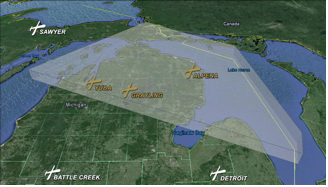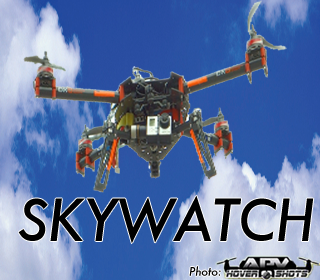
Michigan aviation officials sought to have the shaded region designated an FAA site for testing unmanned aircraft.
Source: MIAASC Test Center
Michigan and two other Great Lakes states lost out on a bid for a Federal Aviation Administration designation to host test sites for drones.
Instead it went to six other states at the first of the year. The designation gives those sites FAA support for civil and commercial exploration of unmanned aerial systems. The competition received 25 applications from 24 states, including Michigan, Minnesota, Ohio and New York.
Despite missing out on this opportunity, Michigan is excited about advancing the fledgling industry, said Rick Carlson, transport and safety manager for the Michigan Department of Transportation’s Office of Aeronautics.
“We want to move ahead and attract business,” he said.
Operators at the testing sites chosen by the FAA in Alaska, Nevada, New York, North Dakota, Texas and Virginia, still must obtain a waiver allowing designated pilots to operate a drone. That’s just like everywhere else.
“The real advantage of being selected would be you would receive expedited handling from the FAA,” said Matt Brinker, aeronautics specialist with the Michigan Department of Transportation.
Additionally, business will flood the chosen test sites because of their federal sponsorship.
Beyond that, not much has changed.
Advocates in Michigan are determined to bring the unmanned aerial industry to the state through research and testing regardless of the FAA’s decision, Carlson said.
They have formed the Michigan Advanced Aerial Systems Consortium, a group of government, academic and industry officials interested in developing unmanned aerial systems.
Agriculture will make up 80 percent of business for unmanned aerial vehicles, said Aaron Cook, director of aviation for Northwestern Michigan College in Traverse City and vice-chairman of the consortium.
Tasks like irrigation, pest control and plant health surveying are some examples of ways unmanned aerial vehicles could assist farmers, he said.
The energy industry in Michigan may also benefit from drones, Cook said. An unmanned aircraft could inspect cell or TV towers, bridges, windmills and power lines.
The craft “can fly where it is very difficult for people to get to,” said Aaron Johnson, business development manager for the Michigan Economic Development Corp. and treasurer of the consortium.
Unmanned aerial systems are heavily regulated in the United States because of federal restrictions regarding the safety of manned aircraft and of people on the ground.

This story is part of Great Lakes Echo’s ‘Skywatch’ series (UAV Photo: APV Hovershots)
The consortium, with its head office at the Alpena County Regional Airport, is a non-profit organization created for the advancement of the industry in Michigan and across the country. The group encourages research and education partnerships with colleges and universities throughout the state.
“Northwestern is in its fourth year of the UAV program and we are the only school in the Great Lakes region offering UAV training,” said Cook.
Unmanned aircraft technology requires expertise in engineering, remote sensing, computer software and flight training, he said.
Alpena Community College officials also see the potential to include drone instruction in their program that teaches students about underwater surveying and recording with robots and remotely operated vehicles.
“I definitely am excited about having complementary technology,” said David Cummins, the marine technology program advisor at Alpena Community College. His program focuses on construction, maintenance and operation of underwater technology.